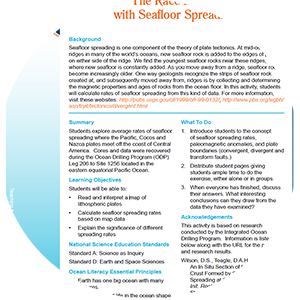Actvity Summary: Students explore average rates of seafloor spreading where the Pacific, Cocos and Nazca plates meet off the coast of Central America. Cores and data were recovered during the Ocean Drilling Program (ODP) Leg 206 to Site 1256 located in the eastern equatorial Pacific Ocean.
Seafloor spreading is one component of the theory of plate tectonics. At mid-ocean ridges in many of the world’s oceans, new seafloor rock is added to the edges of plates on either side of the ridge. We find the youngest seafloor rocks near these ridges, where new seafloor is constantly added. As you move away from a ridge, seafloor rocks become increasingly older. One way geologists recognize the strips of seafloor rock created at, and subsequently moved away from, ridges is by collecting and determining the magnetic properties and ages of rocks from the ocean floor. In this activity, students will calculate rates of seafloor spreading from this kind of data. For more information, visit these websites: http://pubs.usgs.gov/of/1999/ofr-99-0132/, http://www.pbs.org/wgbh/aso/tryit/tectonics/divergent.html
- Standard B: Science as inquiry
- Standard E: Earth and space science
